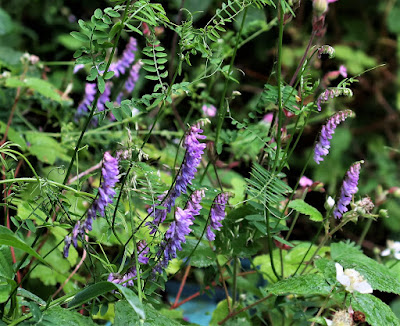The month started very warm and sunny and the western end of Brambly Hedge started to burgeon. The area is roughly a 1 metre cube and is another good example of a very small nature reserve looking rather like a green igloo with various leaves and flowers poking out of the tope. Brambles provide the basic structure and support and some of the other plants that flourish in the sheltered area are tufted vetch, narrow-leaved vetch, goosegrass, black bryony and red campion.
Since September 2003 the author has been making a minimum intervention study of a square metre of land and the immediate surrounding area in his garden in the East Sussex Weald at Sedlescombe near Hastings, UK. By April 2016 over 1000 species of plants and animals (none of which has been deliberately introduced) had been recorded and the area featured on many TV and radio shows including Spring Watch, and The One Show.
Tuesday, June 15, 2021
Diary June 2021
On 8th June I managed to photograph a gout fly, Chlorops pumilicornis. The larvae of these tiny flies live in the shoots and stems of various grasses and cereals causing them to swell, hence the name 'gout fly'. This is the first example I have come across in our garden, so I think most of the grasses are safe.
It remained hot on 15th June and in the middle of the day there was so little insect activity I was reminded of Silent Spring. Maybe it was too hot, maybe it was something else. At least bumblebees seem to be doing quite well this summer except we come across many crawling on the ground or on leaves that seem unusually disoriented, or just not very well. One little highlight of the day was when I spotted a tiny creamy yellow globe on a grass blade in M3. I thought it might be an insect's egg until another even smaller appeared and I could see through my close focus binoculars that they were very small mites. The two faced up to each other then whirled round and round like dancers or duellists. After a few seconds they both retreated to the underside of the leaf. I reflected on how marvellous it was that such tiny creatures, perhaps 0.5 mm across were equipped with a nervous system capable of such complex behaviour.
The Cotoneaster frigida, which flowered and fruited well last year has produced only a few small flowers this year, but is growing well. One of the flowers (below) is very swollen and I think it might be infected by mites or some such.
A male horsefly in Brambly Hedge looking at me head on as a potential blood meal. I haven't been bitten so far this summer.
.
The solitary bog hoverfly (Sericomyia silentis) above turned up on Brambly Hedge on 24th June. This is a large, impressive species and The National Biodiversity Network (NBN) says it is "normally encountered in small numbers in mountain regions and moorland and bog locations." but I usually see it here once or twice a year. It breeds in peaty ditches and small pools and is mainly recorded from Wales and western Scotland. The nearest suitable breeding areas here are 2 or 3 km away in Brede High Woods.
Spiders are far lerss common than they used to be in the early years of the project.. These Pardosa spiders used to scurry about everywhere but I have only seen this one eample (carrying her egg case) this year, probably because the site is more shady than it used to be.
The Phaonia pallida above is, on account of its colour, a very distinctive memmber of the large Phaonia genus of muscid flies. It is not infrequent in M3. The predatory larvae are associated with woodland fungi and rotten wood.
The female tiger cranefly (Nephrotoma quadrifaria) above is the first cranefly I have seen in the project area this year. It was resting in Brambly Hedge West. This is a widespread and common species whose larvae live in soil.
On the botanical front I continue to examine the stigmas in the flowers of the weedier willow herbs as an aid to determination. Below is a good example of the flower of broad-leaved willowherb, Epilobium montanum showing the 4-lobed stigma (and its shadow) in the centre of the flower. M3 also has several plants of American willowherb, E. ciliatum, with club shaped stigmas and I am always conscious that these and other willowherbs are notorious hybridisers.
At the end of the month I noticed some leaves in the area between the Square Metre and Medlar Wood and am pretty certain they are a baby field maple (Acer compestre) a native tree common in our local woods but of which we have no seeding examples in our garden.
This puts the M3 tree list up to 13 species, all self-sown: birch, oak, wild service, goat willow, holly, hornbeam, ash, hazel, hawthorn, field maple, wild privet, yew and sycamore.
If you were wondering about that roundish object towards the bottom right-hand corner of the picture, it is a hanging seed of common sorrel (Rumex acetosa).










